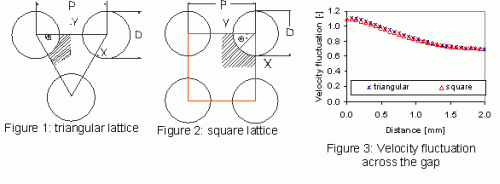Inter-channel exchange
For the design of fuel assemblies, sub-channel analysis codes are widely applied, which require reliable physical models describing thermal-hydraulic phenomena, e.g. inter-channel exchange. Nowadays reliably validated physical models turbulent inter-channel exchange in HLM are missing. One of the difficulties in experimentally studying such local phenomena is a reliable determination of flow parameters in sub-channels. In addition to improved experimental techniques, numerical investigation using three-dimensional Computational Fluid Dynamics (CFD) codes is highly required, to provide basic understanding of physical phenomena involved and data base for the development of physical models which can be used in sub-channel analysis codes.
Although flow behaviour of conventional fluids, as water or air, in rod bundle geometries was widely investigated both experimentally and numerically, there is a big deficiency in understanding the flow behaviour of HLM in rod bundles, Confusing situation still exists in the prediction of flow behaviour in rod bundle geometries, even for flows with conventional fluids as water or air. To gather basic knowledge of HLM flows and experience in the application of CFD codes to HLM-cooled rod bundles, systematic studies are carried out using CFD codes.
Figure 1 & 2 show the regular sub-channels of both triangular and square arrangement. For these two types of sub-channels CFD analysis was carried out to determine the inter-channel exchange across the gap. Figure 3 shows the velocity fluctuation normalized by shear velocity. Base on CFD results and experimental data planned in the near future, physical models of turbulent inter-channel exchange will be derived.

Main references
- X. Cheng, CFD Analysis of Flow Behaviour of Heavy Liquid Metals in Bare Rod Bundles, to be published in Nuclear Engineering and Design, 2005
